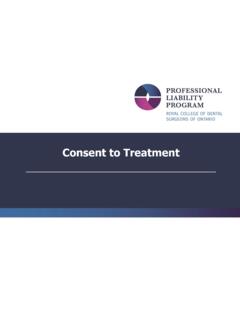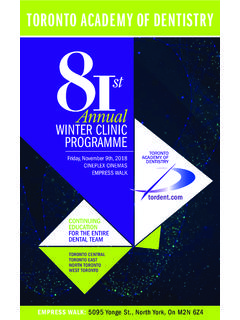Transcription of The Dental Hygiene Process of Care: Is Your Practice on Track?
1 The Dental Hygiene Process of care : Is Your Practice on Track? Entry-To- Practice Competencies and Standards for Canadian Dental Synopsis: Hygienists: The Dental Hygiene Process of care (DHPC) is the structural framework to which all Dental Hygiene Practice should base client specific treatment planning upon. As a registrant our documentation is to reflect assessment, Dental Hygiene diagnosis, Dental Hygiene care plan, recording of interventions as well as the required Process for evaluation. Presented by: Jo-Anne Jones, RDH, President, RDH Connection Inc. Corporate Partner, rdhu Co-sponsored by: What are National Dental Hygiene Competencies? Competencies are used to describe the essential knowledge, skills and attitudes important for the Practice of a profession; in this particular document these competencies describe the foundation necessary for entry into the Dental Hygiene profession in Canada.
2 Transforming the Dental Hygiene They support the Dental Hygiene Process of care by more clearly Experience! articulating the abilities inherent in the assessment, diagnosis, planning, implementation and evaluation of Dental Hygiene services.. Learning Outcomes: How does the DHPC relate to National Competencies? Recognize the components of the Dental The Dental Hygiene Process is the foundation of professional Dental Hygiene Process of care (DHPC) Hygiene Practice and provides a framework for delivering high-quality Dental Understand the relevancy of data Hygiene care to all types of clients in any environment. The Dental Hygiene collection and correlation of findings to Process requires decision making and assumes that Dental hygienists are aid in the remainder of the DHPC responsible for identifying and resolving client problems within the scope of Understand the dynamic nature of the Dental Hygiene Practice 1.
3 Assessment phase and how it impacts The Dental Hygiene Process involves Dental Hygiene diagnosis, assessment, the care plan and implementation planning, implementation and evaluation. The Process can be applied in all Recognize the components of a written settings. Dental Hygiene care plan However, reference to the Dental Hygiene Process of care refers specifically Possess an understanding of evaluation, management and referral as it pertains to direct client care and incorporates the critical thinking Process in to individualized client needs and determining interventions to achieve the desired outcomes. treatment outcomes Assessment of competency related to Best Practices: suggested performance indicators Utilization of the Dental Hygiene Process of care as the structural References & Resources: framework which all Dental Hygiene therapy should be conducted ensuring individualized needs of the client can be met.
4 The Process of care is a dynamic Process that is continually evolving. All Entry-To- Practice Competencies and Dental hygienists are expected to use their knowledge, skill and judgment Standards for Canadian Dental Hygienists regardless of their Practice setting or employment arrangement. January 2010. 1. Notes: Entry to Practice competencies and standards for Canadian Dental hygienists;. Notes: Assess, diagnose, plan, implement and evaluate services for clients _____. The Dental Hygiene Process of care for Today's Dental Hygiene Practice : _____. Traditional performance vs. modern day Process _____. _____ Template approach vs. client specific care and treatment planning _____ Increased knowledge coupled with science & technology _____. Increased awareness of impact of oral health on overall wellness _____. _____ Standard of care vs.
5 Substandard of care _____. _____ Demands & influences of societal change o Interdisciplinary network _____. _____. _____ Recordkeeping Deficiencies: The most common deficiencies found at an onsite review include, however _____. _____ are not limited to;. _____. _____ Failure to have complete periodontal assessments Failure to complete treatment plan _____. _____ Incomplete medical histories _____. _____ Lack of documentation for consent Failure to record time spent on Dental Hygiene interventions _____. _____ Inappropriate billing practices _____ Failure to reassess outcomes of Dental Hygiene interventions _____ No documentation stating radiographic prescription obtained Lack of client specific treatment planning _____. _____ Not following DHPC (use of abbreviations is permissible; resource _____ included in handout). _____.
6 _____. _____ ASSESSMENT: _____. _____ Definition: assessment involves the systematic collection and analysis of data to identify client needs, and oral health problems involving medical and _____. _____ Dental histories, vital signs, extraoral and intraoral examinations, _____ radiographs, indices, and risk assessment Competencies related to a Dental Hygiene Assessment include the ability to: _____. _____ Therapeutic/Preventive Therapy _____. _____ Collect accurate and complete data on the general, oral, and psychosocial health status of clients. _____. _____ Use professional judgment and methods consistent with medico-legal- _____ ethical principles to complete client profiles. References & Resources: Identify clients for whom the initiation or continuation of treatment is _____. All sites accessed September 2014 contra-indicated based on the interpretation of health history and clinical _____ data.
7 Identify clients at risk for medical emergencies and use strategies to _____. Lexi-Comp Chairside Reference Library: minimize such risks. (Use promo code Use appropriate oral health indices for the identification and monitoring of _____. RDHC01). high risk individuals and groups. The Knowledge Network +Network Recognize the influence of the determinants of health on oral health status. References & Resources: Discuss findings with other health professionals when the appropriateness .asp All sites accessed September 2014. of Dental Hygiene services is in question. Oral Health Education Milestones, June 2010. 2. Keir J. Portfolio and Practice Reviews: What to Expect 2010. Milestones June 2010. Notes: Elicit information about the clients' perceived barriers to and support for learning when planning clients' education. _____ Elicit information about the clients' oral health knowledge, beliefs, attitudes and skills as part of the educational Process .
8 _____ Assess the clients' motivation for learning new and for maintaining _____ established health related activities. Assess clients' need to learn specific information or skills to achieve, _____ restore, and maintain oral health and promote overall wellbeing. _____ Assess the individual client's learning style as part of the planning Process . _____ Health Promotion _____ Use information systems and reports for collection, retrieval and use of data for decision making. _____ Identify barriers to access to oral health care for vulnerable populations. _____ Identify populations with high risk of diseases including oral diseases. Analyze health issues in need of advocacy. _____ Recognize political, social, and economic issues in the interest of the _____ public. _____ The Collection of Subjective Data: _____ General client information Personal profile data _____.
9 Dental History _____ Medical History _____. The Medical History: _____ Client's general health Allergies & known sensitivities _____. Pertinent questions related to all body systems _____ Head, eyes, ears, nose and throat Respiratory _____. Cardiovascular _____ Gastrointestinal _____ Genitourinary Muscles, bones & joints _____ Central nervous system _____ Endocrine Hematologic _____. _____ Areas of Concern as per Best Practice Guidelines: Any cardiac condition for which antibiotic prophylaxis is recommended _____. in the guidelines set by the American Heart Association. Any other condition for which antibiotic prophylaxis is recommended References & Resources: or required. All sites accessed September 2014 Any unstable medical or oral health condition, where the condition may affect the appropriateness or safety of scaling teeth and root planing including curetting surrounding tissue 2014 CHEP (Canadian Hypertension Education Active chemotherapy or radiation therapy Program) Recommendations available at Significant immunosuppression caused by disease, medications or Hypertension Canada treatment modalities.
10 3. (p. 21, 22). Notes: Any blood disorders Active tuberculosis _____ Drug or alcohol dependency of any type or extent that may affect the appropriateness or safety of scaling teeth and root planing including _____. curetting surrounding tissue _____ High-risk of infective endocarditis _____ A medical or oral health condition with which the registrant is unfamiliar or which could affect the appropriateness, efficacy or safety of the _____ procedure;. _____ A drug or a combination of drugs with which the registrant is unfamiliar or which could affect the appropriateness, efficacy or safety of the _____ procedure. _____. Reqiurement for Baseline Assessment: _____ Key Points: _____ 1. _____. _____. 2. _____. _____. _____ 3. _____. _____ Access to CPS: _____ (Compendium of Pharmaceuticals & Specialties). Drugs in dentistry under the Clin-Info tab _____ Current Canadian information on more than 2000 products _____ Health Canada advisories and warnings Handouts for patient drug information _____ Updated bi-weekly _____ Free access to CDHA members Considerations for Taking Vital Signs in Dental Hygiene Practice : _____ Definition of Hypertension: _____ A condition where blood pressure persistently exceed specified limits One of the leading health problems in Canada preceding stroke, heart attack, _____ kidney failure, dementia and sexual dysfunction _____ More than 1 in 5 Canadians currently suffer from hypertension with a lifetime risk of 90%.


